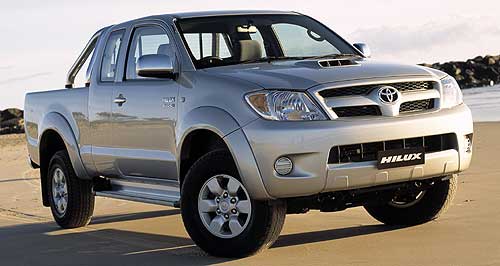Make / Model Search
News - ToyotaToyota predicts sales slip in 2010Tax winner: The Toyota HiLux has been a big seller as small businesses take advantage of federal tax depreciation incentives. Tax incentive hangover will slow car sales recovery next year, says Toyota21 Dec 2009 THE Australian new-car market will struggle to hold current buoyant sales levels next year despite a lift in January from five per cent tarriff cuts on many imported passenger cars, according to Australia's number one car company, Toyota. This is at odds with Ford Australia’s prediction that the 2010 market will exceed this year’s levels, driven by improving conditions in the latter part of 2010. Toyota Australia senior executive director of sales and market David Buttner told GoAuto today that Toyota was expecting an industry sales tally of about 930,000 vehicles for 2009 – well above the “bullish” 900,000 units forecast by Toyota back in January. But he said that after a depressed first half, the 2009 market had been driven upwards by the federal government’s stimulus packages, including tax incentives for businesses, along with an improvement in consumer sentiment. The tax incentives will disappear on December 31, and while the industry will still be delivering many cars fore-ordered under the scheme, it would not be sufficient to drive the market beyond current levels.  Toyota Australia senior executive director of sales and marketing David Buttner. Toyota Australia senior executive director of sales and marketing David Buttner.“Honestly, I think there will be some impact from the investment allowance from a pull-ahead point of view,” he said. “My current prediction is that I don’t think we will quite get to 930,000 next year.” Like Toyota, Ford expects the 2009 market to come in at about 930,000, but it says next year’s sale volume is likely to exceed that. Ford president and CEO Martin Burela told GoAuto earlier this month that while the first quarter of 2010 might be relatively flat, the last three quarters would drive the market to “930,000-plus” as it headed back towards the one million mark. Toyota will be crowned Australia’s number-one car company again this year, needing fewer than 20,000 units to pass 200,000 units for the 2009 calendar year for the sixth year in a row. However, it is also facing the harsh reality of its first year-on-year decline in volume since 2001, with sales falling about 18 per cent from last year’s record tally of 236,983 to a little more than 200,000 units. In percentage terms, this fall is about double the rate of decline of its main local rivals, Holden and Ford, although it will still sell almost as many cars as that pair combined. Mr Buttner described the 2009 Toyota sales fall as “lower than last year by a significant amount”, but said Toyota had been operating in a difficult sales environment, fighting the industry downturn with an ageing product line-up. He said Toyota next year was aiming to improve on its 2009 performance, aiming for another 200,000-plus result. This would be helped by new-model activity, including two next-generation products and seven facelifts. The new models will kick off with the high-profile launch of the Camry Hybrid in February. A new-generation Yaris light car is also thought to be in the pipeline, probably for late 2010. Mr Buttner declined to be drawn on whether Toyota would cut prices in line with the five per cent tariff cuts on imported passenger cars, saying only that Toyota liked to be competitive in the market place. He indicated that the company was mindful of the affect that any price cut would have on resale values, especially for fleet customers. Toyota is likely to keep its powder dry until January 6, when it has scheduled a press conference to trumpet its sales victory in 2009 once the official figures are handed down from VFACTS. Mr Buttner said Toyota would enter the New Year with a large order bank, driven by small businesses taking advantage of the tax breaks. But he said that might lead to supply issues, because the company was unsure when many of those vehicles would have to be delivered. “People that order their car by the end of December 31st, whether they are small or big business, have got to the end of next year to take delivery," he said. “So where’s that going to fall? That might determine next year when there are peaks and when there are troughs.”  Read more |
Click to shareToyota articlesResearch Toyota Motor industry news |










Facebook Twitter Instagram